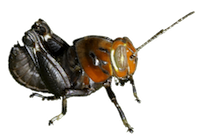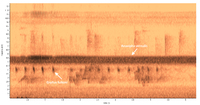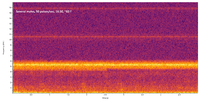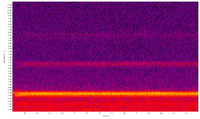Family (Alpha): ACRIDIDAE GRYLLACRIDIDAE GRYLLIDAE GRYLLOTALPIDAE RHAPHIDOPHORIDAE ROMALEIDAE TETRIGIDAE TETTIGONIIDAE TRIDACTYLIDAE
View Gryllidae Members:
Acheta domesticus Anurogryllus arboreus Gryllus unidentified species Gryllus firmus Gryllus fultoni Gryllus pennsylvanicus Gryllus pennsylvanicus/veletis Gryllus pennsylvanicus-veletis Gryllus rubens Gryllus veletis Miogryllus verticalis Velarifictorus micado Hapithus agitator Orocharis unidentified species Orocharis luteolira Orocharis saltator Cycloptilum unidentified species Cycloptilum bidens Cycloptilum pigrum Cycloptilum slossoni Cycloptilum tardum Cycloptilum trigonipalpum Cycloptilum velox Myrmecophilus pergandei Allonemobius allardi Allonemobius fultoni Allonemobius griseus griseus Allonemobius griseus funeralis Allonemobius maculatus Allonemobius socius Allonemobius sparsalsus Allonemobius tinnulus Allonemobius walkeri Allonemobius unidentified species Eunemobius carolinus Eunemobius confusus Eunemobius melodius Eunemobius unidentified species Neonemobius cubensis Neonemobius palustris Neonemobius variegatus Pictonemobius ambitiosus complex Pictonemobius ambitiosus Pictonemobius hubbelli Nemobiinae unidentified species Oecanthus unidentified species Oecanthus celerinictus Oecanthus exclamationis Oecanthus fultoni Oecanthus latipennis Oecanthus nigricornis Oecanthus niveus Oecanthus pini Oecanthus quadripunctatus Neoxabea bipunctata Phyllopalpus pulchellus Anaxipha delicatula Anaxipha exigua Anaxipha litarena Anaxipha rosamacula Anaxipha thomasi Anaxipha tinnula Anaxipha tinnulacita Anaxipha tinnulenta Anaxipha vernalis Anaxipha new species near vernalis Anaxipha unidentified species Cyrtoxipha columbiana Falcicula hebardi Gryllidae unidentified species NC Records
Anaxipha vernalis Walker & Funk, 2014 - Spring Trig
No image for this species.
Taxonomy
Family: Gryllidae
Subfamily: TrigonidiinaeTribe: TrigonidiiniSynonym: Anaxipha n. sp. G Comments: One of thirteen species in this genus that occur in North America north of Mexico (SINA, 2017); nine have been recorded in North Carolina. Vernalis belongs to the Delicatula Species Group, of which declicatula is the only other described species.Species Status: Treated as delicatula by Fulton (1951, 1956) based on genitalic features. Recognized as a separate species by Walker and Funk (2014). There are possibly two sibling species present, based on different song types produced in the spring and summer. However, these forms may represent different generations, as appears to be the case in a Neoconocephalus triops (see account page for that species).
Identification
Field Guide Descriptions: Online Photographs: SINA, Google Images ,
iNaturalist , GBIF Technical Description, Adults/Nymphs: Walker and Funk (2014)SINA 632a.htm Comments: A very small, brown Trig. Unlike most members of the Exigua Group, it lacks a stripe on the lateral face of the femur (Walker and Funk, 2014). Structural features -- particularly the number of pegs on the stridulatory file -- must be examined to identify this species. This species is very similar in appearance and in genitalia to delicatula but they can be easily distinguished by their songs.Total Length [body plus wings; excludes ovipositor]: 6.2-6.8 mm, males; 4.8-6.7 mm, females (Walker and Funk, 2014)Structural Features: Stridulatory file with about 106 teeth (range 102-112). Ovipositor longer relative to hind femur, HF/OV < 3.1 (see Walker and Funk, 2014 for additional structural characteristics). Walker and Funk reported that no long-winged forms have been observed.Singing Behavior: Songs consist of continuous trills, with the number of pulses per second ranging from 20 to 60 per second and the corresponding carrier frequencies (pitch) ranging from 3.5 to 6.5 (see graph below). Songs given in the spring last several minutes at at time, but later in the season songs are more often broken into segments that are 3-4 seconds in length, with gaps of up to 2 seconds separating them. They also differ in the relationship between pulse rate and dominant frequency (see graph below).
During the spring, songs can be confused with those of Gryllus rubens , which has trills with similar pulse rates but with a much lower pitch. Although these differences are possible to pick out by ear, the use of spectrograms is recommended to distinguish these two species. Anaxipha exigua has a similar continuous trills but has a dominant frequency at 77 F of 7.2. Exigua also calls later in the season than vernalis , although there is a period of overlap in late July.Diagnostic Song Parameters: Recording playback at normal speed.
Download Video:
"MP4"
Nymphal Stages and Development: Apparently undescribed but unlikely to be distinguishable
Distribution in North Carolina
County Map: Clicking on a county returns the records for the species in that county.
Adult Dates: Click on graph to enlarge
Habitats and Life History
Habitats: Fulton (1956) describes the habitat as primarily fresh-water marshes and stream borders, especially with thick herbaceous growth, including both Lizardtail and tall wetland graminoids. We also have records from floodplain forests more generally and from seepage slopes in the Sandhills. Diet: Apparently unrecorded; possibly omnivorousObservation Methods: Singing males are most easily detected both day and night. They may also be captured using sweep netting, although Walker and Funk (2014) state that this species is particularly difficult to capture.Abundance/Frequency: Can be locally abundant; one chorus heard in Chapel Hill extended well over a half mile along a creek, with no gaps in singing malesAdult Phenology: Fulton (1956) gives the dates for adult vernalis (= delicatula ) in the Piedmont of North Carolina as May 22 to July 21. We have, however, recorded them as early as April 6 in the Sandhills. We also have records -- possibly representing either a second brood or a different species -- from July to at least early August.
Status in North Carolina
Natural Heritage Program Status: Natural Heritage Program Ranks: GNR SNR [SU]State Protection: Has no legal protection, although permits are required to collect it on state parks and other public landsComments: In addition to Anaxipha vernalis sensu strictu, we may have an undescribed sibling species. Both have been recorded in the same habitats and appear to overlap in range. Although neither one appears to be rare or declining in North Carolina, their taxonomic status needs to be clarified before we can determine if they are of any conservation concern.
Image Gallery for Anaxipha vernalis - Spring Trig Recorded by: Steve Hall Recorded by: Jim Petranka Recorded by: Ken Kneidel Recorded by: Jim Petranka Recorded by: Steve Hall and Bo Sullivan Recorded by: Steve Hall and Bo Sullivan Recorded by: Steve Hall, Savannah Hall, Cordell Buckingham Recorded by: Steve Hall
MP3 Gallery for Anaxipha vernalis - Spring Trig 1
Your browser does not support the audio element.
Recorded by: Jim Petranka 2
Your browser does not support the audio element.
Recorded by: Ken Kneidel 3
Your browser does not support the audio element.
Recorded by: Jim Petranka

 »
»






